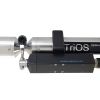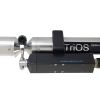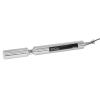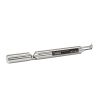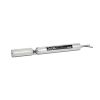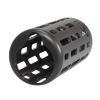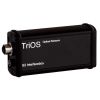TriOS W55 V2 Mechanical Wiper
The TriOS W55 V2 is a mechanical wiper designed for use with the NICO, NICO plus, and OPUS UV sensors.
Features
- Cleans UV optics of sensor, extending maintenance intervals
- Wipe is initiated from supply voltage of 12-24 VDC
- Requires wiper axis & blade set for appropriate path length
- Expedited repair and warranty service
- Lifetime technical support
- More
Overview
The TriOS W55 V2 Mechanical Wiper offers an additional cleaning option for TriOS NICO, NICO plus, and OPUS sensors with path lengths up to 10mm. The wiper housing can be mounted on the sensor in just a few steps and offers reliable cleaning of the measuring window. The new magnetic lock of the axle allows for a quick and easy wiper blade change without any tools.
Blockage Detection
The new version of the wiper now has blockage detection and removal and a service mode that increases the life of the wiper with regular use. The accessory can also be used in seawater up to a depth of 10m.
|
Power Supply
|
12-24 VDC (±10%)
|
|
|
Power Consumption
|
About 2-6 W in operation; max. 0.75 W in standby
|
|
|
|
||
|
Path Lengths
|
2mm, 5mm, 10mm
|
|
|
Maximum Pressure
|
3 bar
|
|
|
Protection Type
|
IP68
|
|
|
Inflow Velocity
|
Up to 10 m/s
|
up to 32.8 fps
|
|
Oparating Temperature
|
+2 to +40°C
|
~ +35.6 °F to +104 °F
|
|
Storage Temperature
|
-10 to +70 °C
|
~ +14 °F to +158 °F
|
|
|
||
|
Control Connection
|
4-pin M8-plug, includes 1.5m pigtail adapter
|
|
|
Trigger Input
|
5-24 VDC ±10%
|
|
|
Current Consumption of Trigger Input
|
2-15 mA
|
|
|
Operating Time (max.)
|
3 seconds
|
|
|
|
||
|
Dimensions L x ø
|
175mm x 80mm
|
~ 6.9“ x 3.2“
|
|
Weight
|
0.52 kg
|
~ 1.15 lbs
|
|
Materials
|
NBR, POM, PE (PP, EPDM), Titanium or V4A
|
|
|
Warranty
|
1 Year (EU & USA: 2 Years)
|
|
|
Support Effort
|
Typically ≤ 0.5 hours/month
|
|
|
Maintenance interval
|
Application dependent | |
In The News
Save our Bogs! Culture, Conservation and Climate Action in Ireland’s Peatlands
Characterized by long-term accumulation under waterlogged conditions, peatlands exist on every continent and account for 3-4% of the global land surface . Small but mighty, these often overlooked wetland environments are estimated to hold as much as one-third of the world's organic carbon in their soil—twice the amount found in the entirety of the Earth's forest biomass. While healthy peatlands can trap and store carbon, regulate water, and provide important habitats for rare species, human alteration has disturbed peatland carbon and nitrogen cycles on a global scale. Approximately 12% of the world’s peatlands have been drained and degraded through conversion for agriculture, forestry, infrastructure development, and other uses.
Read MoreSargassum Surge: How Seaweed is Transforming our Oceans and Coastal Ecosystems
Until recently, Sargassum –a free-floating seaweed–was distributed throughout the Sargasso Sea , the north Caribbean Sea, and the Gulf of Mexico. But in the space of a decade, this seaweed has, as one scientist remarks , “Gone from a nonfactor to the source of a terrible crisis.” Driven by climate change, anomalous North Atlantic Oscillation in 2009-2010 and a glut of anthropogenic pollutants, sargassum has proliferated. Seasonally recurrent mats as deep as 7m now bloom in the “Great Atlantic Sargassum Belt” (GASB), which covers areas of the Atlantic from West Africa to the Caribbean Sea and Gulf of Mexico. Every year, millions of tons wash up along the shores of more than 30 countries . Dr.
Read MoreGreat Lakes Research Center: Designing Targeted Monitoring Solutions
According to the National Oceanic and Atmospheric Administration ( NOAA ), the Great Lakes have more miles of coastline than the contiguous Atlantic and Pacific coasts combined and contain 20 percent of the world's freshwater, making it a critical region to protect and conserve. Continuous monitoring and data-informed resource management are key components of managing waters in the region. Hayden Henderson, a research engineer with the Great Lakes Research Center (GLRC), designs and deploys monitoring platforms throughout the Great Lakes. With a background in environmental engineering, Henderson enjoyed the challenge of creating systems and making them work to obtain difficult, remote measurements.
Read More






